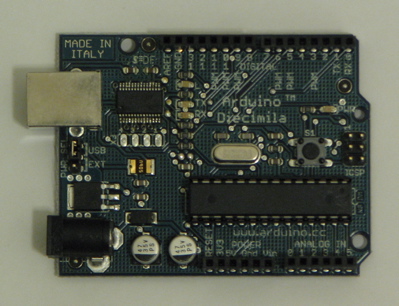For the last month or so I’ve been playing around with Arduino (“open-source electronics prototyping platform “) and Processing (“open source programming language and environment for people who want to program images, animation, and interactions”). Both are very, very cool. The Arduino programming environment is based on Processing, so learning both isn’t much extra effort.

So far with Processing I’ve mostly been working with existing code examples to talk to code I’ve written that runs on the Atmel microcontroller on the Arduino board. I’ve lately been hacking with the Minim library for working with audio, inspired by a link on someone’s Twitter feed to someone else’s experiment with Minim and an Arduino. I’ve cleaned up and reformatted his code in my own fetishistic manner, and now I’m looking to extend it. After all, I’ve got a pile of LEDs begging to be soldered to something.

On the Arduino front, I’ve been working my way through Ladyada’s tutorial and the first couple of chapters of Tom Igoe’s book, Making Things Talk. At first I was kind of annoyed when I realized how incomplete the explanations where for some of the projects. But then I decided that that just motivated me more to figure things out for myself. And they’re really not that incomplete, anyway.
Arduinos are quite inexpensive, so if you’re the least bit motivated to combine your programming experience with some basic electronic hardware hacking, I highly recommend checking them out. I bought most of my gear from Adafruit and Spark Fun.
Pingback: basic electronics tutorial | Digg hot tags